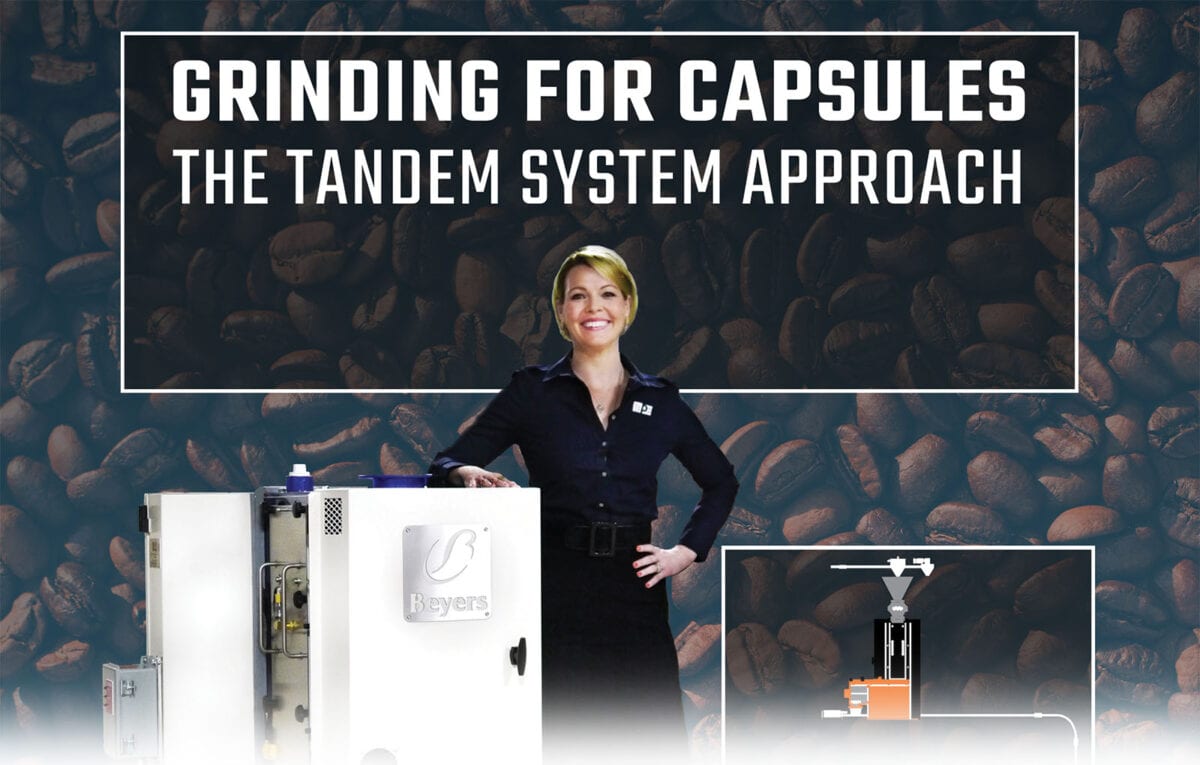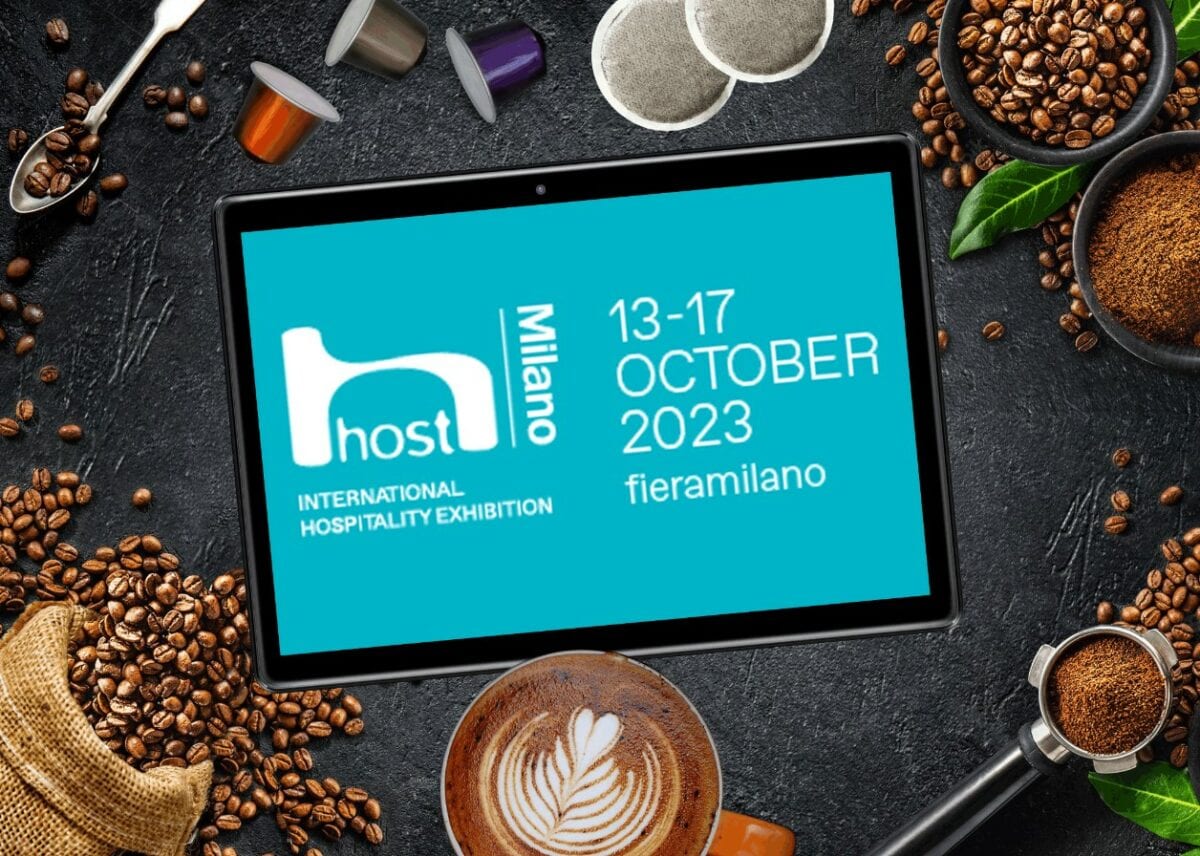In a standard French press, coarse grind, one coffee bean grinds into 100 – 300 particles; for a regular drip filter grind, one bean becomes 600 –1,000 particles; and in a filter fine grind for vending, gone bean equals 1,000 – 3,000 particles. In a Turkish grind, one bean pulverizes into approximately 45,000 particles!
Turkish coffee might not sound very appealing to today’s specialty gourmands drinking a frozen high octane café latte. Yet clearly, this type of coffee appeals to a wide segment of the world’s coffee drinking population. Some say it’s the earliest way of drinking coffee.
For this type of coffee, the Ultrafine grind is boiled with water and is served very hot and often highly sweetened. The fine particles clump in a “mud” at the bottom of the cup. (No, you don’t drink it.) This high caffeine coffee is enjoyed around the globe, but mainly in the Middle East, Turkey, Russia, much of Central and Eastern Europe, Central Asia and northern Africa, with spotted markets around the globe.
“We estimate our total potential market at 1 billion people, 20% of the population,” said George Najjar, director of Café Najjar. He took over his father’s business, then a vending services company in 1973, and has slowly built Café Najjar into a well-recognized name. Today, Café Najjar is the leading coffee brand in Lebanon, with major inroads into surrounding areas, especially Egypt and Saudi Arabia.
The problem for Turkish coffee drinkers is that it isn’t easy to find a good cup of Turkish coffee. Najjar wanted to improve the quality of his product and expand further. But the difficulties inherent in the grinding of Turkish coffee severely limited him. The Najjar family, with a long history in the coffee business, was well aware of the problems. They knew what they needed, but did not know where to get it.
Figure 1 Najjar’s product, an Ultrafine ground coffee, is surprisingly hard to produce. In a standard French press, coarse grind, one coffee bean grinds into 100 – 300 particles; for a regular drip filter grind, one bean becomes 600 – 1,000 particles; and in a filter fine grind for vending, one bean equals 1,000 – 3,000 particles. In a Turkish grind, one bean pulverizes into approximately 45,000 particles! (Figure 1)
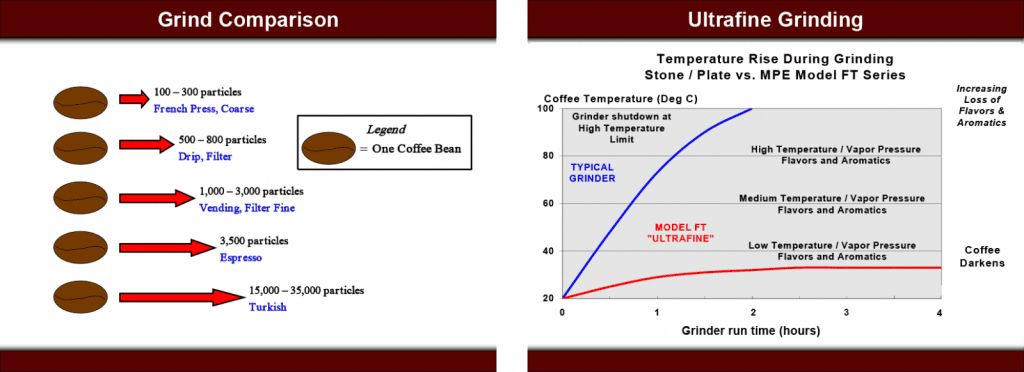
“Producing such grinds takes a lot of energy, and energy equals heat,” said Daniel Ephraim, president of Modern Process Equipment (MPE), the world’s leading supplier of grinding equipment. Since the earliest days, stones and plates were used to produce the “controlled explosions”, over several stages, necessary to produce 45,000 particles per bean required for a Turkish grind.
A typical Turkish grinder passes beans through several chambers, each chamber grinding the bean particles further into the desired density. As this happens, the tremendous energy heats the stones and plates rapidly. In one hour, temperatures reach 60 – 80ºC and, by two hours, the temperature is 100ºC. (Figure 2)
The problem with heat is just about everything. “Even at 40ºC, important volatiles begin to burn off,” said Najjar. The “volatiles,” that is, flavor and aroma, burn off quicker as the temperature rises. At 100ºC, virtually all volatiles are lost. In two hours, the grinders must shut down for a “cooling off” period of up to three hours. The heat generated by this process also turns the grinder into a sort of “surrogate” roaster, darkening the coffee.
“Of course, the place to roast coffee is in the roaster, not the grinder,” said Ephraim. Turkish coffee is typically very dark, and often that is not by design.
Another disadvantage is the general inefficiency of stones, burrs and plates in producing an even grind. Particle size diverges widely from the manufacturer’s requirements. This becomes apparent when the stones or plates begin to wear, which doesn’t take very long.
Figure 3 The typical stone or plate pairs lasts only one to two weeks. Therefore, grinders must be serviced often, and worn parts replaced. Due to the downtime from heat and wear, typical roasters designed for a Turkish grind only operate at 10% of their actual capacities. (Figure 3)
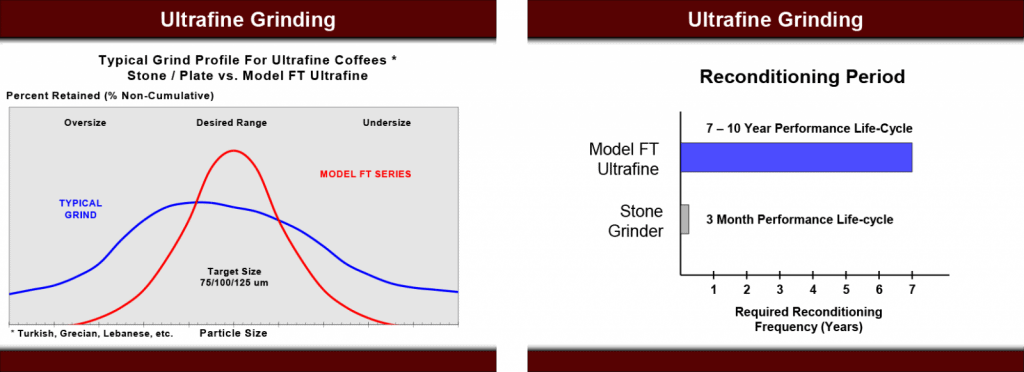
The interrelated problems of heat, varying particle size and wear, with the resultant downtime, loss of flavor and aroma and darkening of the roast, had to be addressed. Najjar knew there had to be a better way. He began searching in the late 1970’s for an answer.
It wasn’t until 1989, when he approached MPE, that he found a company willing to take the challenge.
MPE supplies 95% of the industrial coffee grinders in North America and is a primary supplier throughout the world. Ephraim began examining all existing methods of Ultrafine grinding. He soon realized what Najjar already knew – there was nothing on the market currently addressing these problems.
MPE began the search for a suitable material to apply to a roller technology method, thereby replacing the easily worn stones and plates. His company searched for materials, but none worked ideally to address the problems of heat and wear. Then Ephraim decided to look at newer, less known materials. It was then that he struck gold.
The National Aeronautics and Space Administration (NASA) developed a material that is five times harder than chrome for use in coating the outside of space capsules. This “diamond hard”, heat-resistant material protected the capsule upon re-entry into the Earth’s atmosphere. MPE tested the material and quickly obtained the licensing.
Ephraim applied the material to a roller mill to produce the “FT” Ultrafine Granulizer™. The new material gives the “FT” extremely high durability and is also heat-resistant. Temperatures remain around 22–- 25ºC, well below the burn-off level of important volatiles, keeping flavor and aroma intact. With control over temperatures, there is no need for “cooling off” and, even more significantly, the “FT” operates 24 hours a day.
The fully computerized “FT” controls the water-cooling of the rollers and the automatic feed rate of beans into the grinder. Ephraim reiterates that the “FT”’s integrated feeding system is also key: “Feeding systems are not included with most grinders, and this can be a significant expense.”
The control of heat levels ensures that the grinder acts like a grinder, not a roaster. Blends come out the same color and temperatures as they go in.
The Ultrafine uniform process also produces a greater bulk density. “Customers can expect to get 20 – 25% more coffee per weight than regular Turkish grinds,” said Ephraim.
One of the most crucial elements of the “FT” is its resistance to wear. The “FT” grinders installed at Najjar since 1992 continue to operate flawlessly, 24 hours a day, and show no wear. This is a significant benefit, considering that the stones and plates had to be replaced every one to two weeks. (Figure 4)
Najjar said he runs the “FT” 24 hours a day and likes to run it at 600 kilos per hour. “Originally, we ran it at 450 kilos, and we’ve had it up to a maximum of 800 kilos an hour,” said Najjar.
According to Ephraim, MPE developed the project as if it were a lunar mission. Beirut is 7,000 miles away, and apparently no one at the company was too keen on spending much time when the civil war was in progress. Najjar’s factory was the scene of at least one battle during the war. “When we sent the product out, it had to work … it could not come back,” said Ephraim.
When the Najjar’s, George and his father Michel, founder of the company, visited Chicago in 1992 to see the small test model produced by MPE, they were stunned. “(Michel) said he never thought he would live to see such a product in his lifetime,” said George. (Figure 4)
In 1992, Najjar needed 70 grinders to produce enough coffee for his customers. One Model “FT”, installed in 1993, replaced all of them. (Another “FT” was delivered in 1994 and two more have been installed since then.)
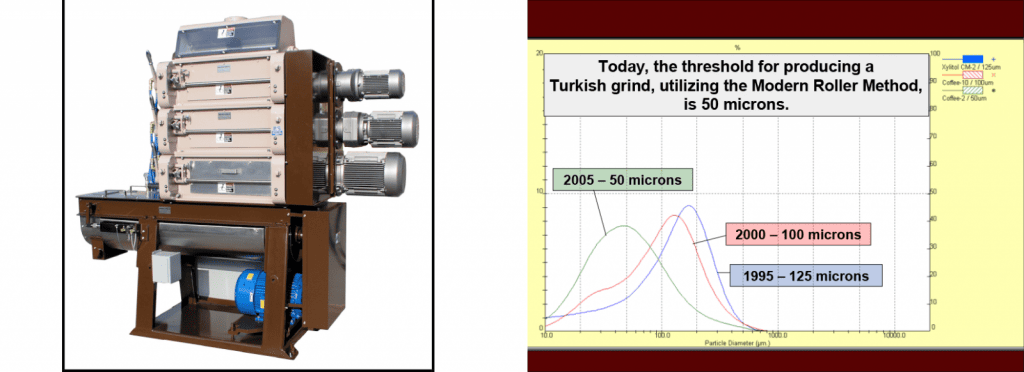
“We’ve been operating up to 24 hours a day without difficulty,” said Najjar at an interview. “And we’ve had major success in the marketplace. Those that enjoy Turkish coffee, fully 20% of the coffee drinking world, had to suffice with varying tastes and lack of aroma.
Café Najjar is now able to deliver to the marketplace a superior coffee product, better than was ever available before. “In the first year, we increased our business by 9%,” said Najjar.
“Our top priority is to keep a customer after you get them,” said Najjar. “Customers become loyal to a brand. If you find a brand you like, why change?”
Café Najjar’s plant in Beirut is sort of a show place for the new grinder. Coffee manufacturers in the region, from Greece to Turkey to Indonesia, visit the factory to see the “FT” in operation.
Figure 6 Ephraim said that MPE has since sold and installed the grinder in virtually every Turkish market throughout the world, including most of the major Turkish coffee manufacturers. (Figure 6)
While Turkish grinding represents one of the most challenging, and rewarding, markets, MPE also meets the challenges of the brewed coffee market (drip, urn, soluble, etc.) with the same ingenuity and expertise in order to provide the highest quality coffee grinders for every market.
“Looking back on it, the project seems easy,” said Ephraim. “But, back then, finding the material was a long shot. We were just about ready to throw our arms up in the air. But the Najjar’s were very encouraging and believed that we could do it.”

